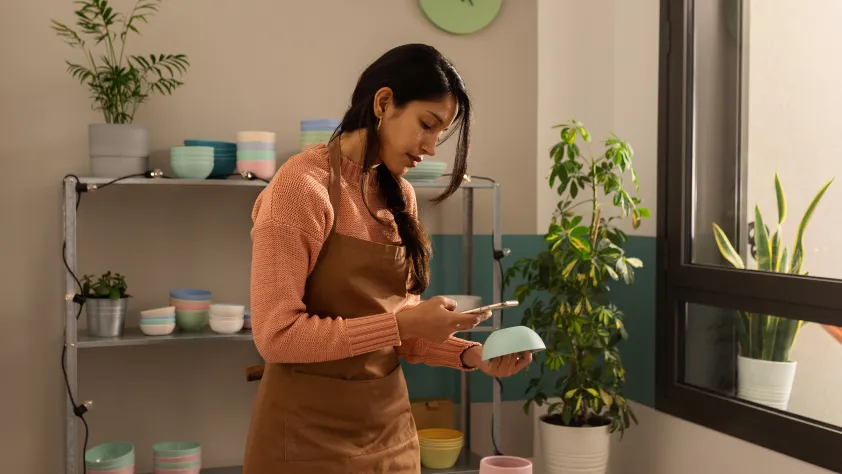
Customers
A Guide to Offering Exceptional Service That Drives Revenue
April 12, 2023
Customers want more than just their questions answered and their orders filled — they want to build meaningful relationships with the brands they buy from. A recent customer survey by Iterable found that “83% of consumers are more likely to purchase from a brand they have an emotional connection to.”1
To build these emotional connections, brands can’t only offer traditional customer service — they need to create a culture of customer care. Shrewd customer care leaders know the difference is all about building long-term relationships that help drive revenue for your organization.
What is customer care?
Customer care means interacting with customers in a way that builds positive emotional connections. It’s not just about helping customers. Customers expect to be treated with empathy, respect, and kindness as you build trust and establish a genuine and hopefully long-term relationship.
How is customer care different from customer service?
Customer service is purely reactive — your team responds to customers’ inquiries and resolves their issues. Customer care transcends simply solving problems, in part by being proactive. It's about understanding and anticipating your customers' needs – both with your products or services, as well as resources to educate them about how to utilize their purchases.
Let’s look at a couple examples:
Your customer messages you to complain that a toy they ordered didn’t arrive in time for Christmas. You look into what might have happened and explain to the customer why the package didn’t arrive on time. You apologize and offer them a refund and a discount on their next purchase.
That’s customer service.
Now imagine the same situation. You respond to the customer in the same way — offer an apology, investigate the problem, and offer a refund. However, you also take the initiative to recommend the following solution:
Send the toy again, make it look like it came from the North Pole, and include a note from Santa explaining why the gift didn’t arrive in time. You don’t have to do any of these things, but this kind of proactive service is what defines customer care.
That’s customer care.

How does customer care drive revenue?
Quality customer care incentivizes your audience to buy from your company. A recent Webhelp survey found that customers who recall an emotional connection to brands would:
- Pay slightly more for their products/services (54%)
- Recommend a brand (63%)
- Be more loyal to the brand as a result of the emotional connection with that brand (66%)2
Here’s a breakdown of how customer care translates into revenue.
Customer care helps brands build trust
Emotional connections establish trust between customers and brands. And according to a recent survey by Clear Channel, 81% of consumers say that trust is “a deciding factor in their purchase journey.”3
Trust is earned by displaying honesty, transparency, and dependability in your customer communications. When providing customer care, don't make promises that you know you can't deliver on. Don't claim an issue is a "quick fix" when you know it isn't. Be transparent.
Sure, customers are always looking for fast service. But if a solution can't be found quickly, tell them. Customers appreciate honesty and can set their expectations accordingly.
Customer care shows buyers you value them
The relationship you have with customers is never a one-sided one. Acknowledge that you are grateful for customers that, with their business, support you and help you succeed every day.
Customer care makes customers feel appreciated. According to a survey by Handwrytten, only 20% of customers feel that way. The survey also shows that when consumers feel appreciated, they are:
- More likely to buy more (60%)
- More likely to spend more per purchase (49%)
- More likely to tell family and friends about you (63%)4
One of the easiest ways to demonstrate appreciation is to offer customers tangible gifts like exclusive freebies and special offers that show how much you value their business and loyalty. Customizing these offers based on previous purchases can be the cherry on top, further establishing a sense of value.
Customer care invites testimonials
Customer care can help you build a positive brand reputation through testimonials. People love sharing positive experiences with their friends and family, but you can encourage them to write public reviews and recommendations. According to BrightLocal’s 2022 Local Consumer Review Survey, 67% of customers will consider leaving a review for a positive experience.5
Testimonials are like jet fuel for sales numbers. According to a recent Wyzowl study, 77% of customers say that a brand's testimonial video has played a part in convincing them to buy from that brand and 95% say that reviews influence their purchasing decisions.6
Customer care creates close relationships in which asking for a testimonial becomes easy. Best of all, impactful customer experiences make for powerful customer stories that are not just emotionally resonant but also sincere and heartfelt.

How to offer customer care via WhatsApp
Messaging apps, like WhatsApp, provide the perfect space for providing customer care. They allow you to have direct, personal conversations with customers, so they can get to know your brand like they would get to know a friend.
Not sure how to get started with messaging-based customer care? Here are some ideas:
Use conversational messaging
Messaging apps are the perfect channel for connecting with your customers in a friendlier and more casual manner. Customers already use WhatsApp to chat with friends and family, so they’re comfortable using this channel to have casual conversations.
You can communicate with emojis or send gifs to keep the conversation casual. Ask them how their day is going or how they plan on using your product. Converse as if you’re speaking to friends, not prospects.
Since you know your brand and target audience best, it should be easy for you to adapt your messaging to fit the voice and tone that resonates best with them.
Send multimedia messages
WhatsApp, along with most other modern messaging apps, supports multimedia communication, making it easy to communicate with customers via text, voice, images and even video.
Multimedia messages are great because you can send personalized messages and communicate directly with customers, even when you’re not able to connect in real time.
Here are a couple of ways to use videos in customer care:
- Say “thank you” with a recorded, personalized video message instead of a dry email that reads like a template.
- Offer technical support via recorded videos or interactive images if customers don’t have time for live tutorials or demos. Create personalized walkthroughs tailored to the customer’s questions and concerns.
Customers already love multimedia. Wyzowl's most recent video marketing report found that "96% of people have watched an explainer video to learn more about a product or service."7
And since you’re addressing customers with your image, voice, and words all at once, the emotions in your messaging will translate better and connect with customers more easily.
Keep customers in the loop
Customer issues can’t all be solved instantly. If it’s taking a while to find a resolution, stay in touch with the client through your messaging app so that they know you’re still working on it.
You could send automated message notifications triggered by events like an action (an agent has seen your ticket), or send them periodically to acknowledge that your team is working on the problem and hasn’t forgotten about it.
Order tracking presents an opportunity for your business to take advantage of popular messaging app features. You can program chatbots to send clever and entertaining order and shipping updates to make the process more casual and fun.

Create caring experiences on WhatsApp
Let’s be clear; customer care is more difficult than customer service. But the benefits of creating meaningful connections with customers have never been more apparent.
Customers who feel emotionally engaged with your brand are not only more likely to make a purchase, but become a recurring purchaser as the nurturing relationship, loyalty, and trust between them and your brand continues to evolve.
To learn how your business can use the WhatsApp Business Platform to communicate with customers, check out this piece on quality messaging and another on customer service personalization.